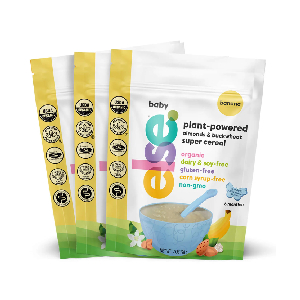A Healthy Alternative for Infants with Cow’s Milk Protein Allergy
Looking for a safe option for infants with cow’s milk protein allergy? Explore this article for information and resources on this important topic.
Published May 6, 2024.

Many parents worry when their calm and happy newborn infant becomes increasingly “fussy” and difficult to console. Often, the concern is whether or not a milk intolerance is the causative factor. During the first year of life, most of an infant’s nutrition comes from either breast milk or formula feedings. If formula is chosen, the most commonly used versions are made from cow’s milk (source). If breastfeeding, a lesser amount of milk protein is transmitted to the infant when a mother consumes dairy. Unfortunately, some infants do not tolerate this exposure and have what is called a cow’s milk protein allergy (CMPA). This type of allergy can be detrimental to the health of the infant, and frustrating for the parents.
Although it is difficult to determine the worldwide incidence of CMPA, the best estimates are between 2 to 7.5 percent (source). The clinical signs can vary, and the immune response may be IgE-mediated, non-IgE-mediated, or both. Some allergy symptoms develop immediately after exposure, characterized by a rash in the areas of milk contact, facial swelling, and vomiting. More commonly, however, the reactions are seen hours to weeks later, presenting as atopic dermatitis, diarrhea (often with blood), irritability, and poor weight gain. Unfortunately, both skin prick tests and blood tests for milk allergy are inaccurate in this age group. The diagnosis, therefore, is based on symptoms (source).
Clinical Presentation
The classic case scenario of CMPA is a three-week-old who is difficult to console despite frequent feedings, and whose parents have noticed “streaks of blood” in the stool. Weight loss is noted, and blood is confirmed by a rapid occult blood stool test. This blood is due to irritation of the intestinal mucosa by cow’s milk. In more subtle cases, an infant has normal stools and an appropriate weight gain, but develops increasingly severe atopic dermatitis. By three of four months old, most of the skin may be covered in excoriated lesions despite the application of emollient creams. The infant may seem to constantly scratch accessible lesions, or to rub against surfaces for itch relief. A rare but severe form of milk allergy is food protein-induced enterocolitis (FPIES) (source). In this situation, the vomiting and diarrhea ensue two hours after of ingestion milk protein, and are severe enough to cause dehydration. Some infants even have a “shock like” appearance with hypotension, lethargy, and fever, mimicking sepsis. In each of these clinical situations, removing cow’s milk protein from the infant’s diet either resolves or improves the symptoms.
Misconceptions about Infant Colic and Lactose Intolerance
The majority of infant colic is NOT due to an allergy to milk protein. Colic has been defined by the Wessel’s criteria as prolonged infant crying, fussiness, and irritability (source). Typically, colic episodes occur during the early evening, and can last for several hours. Symptoms become evident by three weeks of age, and self-resolve around three months old. Colic is a diagnosis only given after all other possibilities have been excluded. Despite its self limited nature, these symptoms can be very distressing for parents. In an effort to provide relief, parents often try a variety of infant formulas, hoping to find one that will help. They may even resort to ones designed for infants with CMPA. However, research studies have not shown any benefit nor improvement in symptoms when these specialty formulas are used for colic (source). Instead, parent support and infant soothing techniques are the best remedies.
Additionally, there is confusion among parents about lactose intolerance. Unlike CMPA, this intolerance is the inability to digest the naturally occurring sugar in cow’s milk (source). It is due to the reduced amount or the absence of lactase, an intestinal enzyme needed to digest lactose. There is a hereditary predisposition to developing lactose intolerance, and it is more common in certain ethnic groups. Except for a rare, congenital version seen mostly in Finland, lactose intolerance is never present at birth (source). The youngest cases have been documented at the age of two among Asian, African, and Latino ethic groups, and by age five among those of European ancestry. Despite the marketing claims of companies regarding “low lactose” infant formulas, there is no data to support their use. Infants do not experience lactose intolerance.
CMPA Treatment Recommendations and A Role for ELSE Infant Formula
For breastfed infants with CMPA, the recommendation is for the mother to avoid dairy in her diet (source). In all other cases, a partially hydrolyzed or amino acid-based infant formula is recommended. Due to the high incidence of co-existing soy allergies, soy-based formulas are not recommended (source). An infant baby formula such as ELSE may be beneficial for infants with CMPA. It is cow’s milk free formula and soy free formula, and complies with the standards established by ESPGHAN for added vitamins, minerals, DHA and ARA. Unlike competitor products on the market, made from cow’s milk, ELSE contains almond and buckwheat proteins. This is ideal because it is free of the most common allergens that cause adverse reactions in infants (milk, soy, wheat, egg, and peanut). Comparatively, corn syrup is the first ingredient in two of the most popular hypoallergenic formulas. The currently available elemental formulas are no better, with glucose or corn syrups as the primary ingredient. Early avoidance of sugar may prevent infants and toddlers from developing a preference for sweet flavors (source). Reduced sugar in an infant formula may also be preventative against decay of primary teeth. Compared to other available products designed for infants with cow’s milk protein allergy, ELSE has clear benefits. With its unique and high quality infant formula ingredients, ELSE formula will be a welcome addition to the infant formula market.




